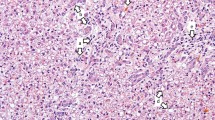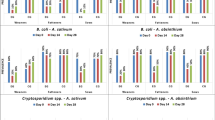Abstract
The influence of the quality and quantity of diets on the disposition kinetics of albendazole were studied in sheep in two different experiments. The plasma concentration profiles of albendazole sulphoxide and albendazole sulphone were measured following intraruminal administration of albendazole at 5.0 mg/kg body weight in weaner sheep offered three different diets: 100% green Sorghum spp., 100% dry mature Cenchrus ciliaris hay and a 50:50 mix of these two diets. The peak plasma concentrations and the availability of the albendazole metabolites, as measured by the area under the concentration–time curve, were significantly higher (p<0.01) in the animals offered exclusively dry fodder compared to other diets. Changing the diet from dry to green fodder resulted in a significantly lower systemic availability of the drug metabolites. It is suggested that a decreased transit time of the digesta in the bowel on the green diet, with its high water content, limited the systemic availability of the drug by reducing the time available for gastrointestinal absorption.
An experiment on the influence of different levels of pretreatment fasting on the pharmacokinetics of albendazole revealed significantly higher (p<0.05) plasma concentrations of the anthelmintically active sulphoxide metabolite from 12 h onwards following administration of the drug in animals subjected to 24 h of pretreatment fasting compared to other groups with pretreatment fasting of 8, 12 or 18 h. The area under the concentration–time curve and the minimum residence time of the drug metabolites were significantly greater (p<0.05) in animals that had been fasted for 24 h. It is suggested that fasting induces a decrease in the flow of digesta through the gastrointestinal tract of ruminants and prolongs the duration of dissolution of the drug, resulting in enhancement of the absorption of albendazole and of the systemic availability of its metabolites.
Similar content being viewed by others
REFERENCES
Ali, D.N. and Chick, B.F., 1992. Effect of feed type on the pharmacokinetic disposition of oxfendazole in sheep. Research in Veterinary Science, 52, 382–383
Ali, D.N. and Hennessy, D.R., 1993. The effect of feed intake on the rate of flow of digesta and the disposition and activity of oxfendazole in sheep.International Journal for Parasitology, 23, 477–484
Ali, D.N. and Hennessy, D.R., 1995. The effect of level of feed intake on the pharmacokinetic disposition of oxfendazole in sheep. International Journal for Parasitology, 25, 63–70
Alwash, A.H. and Thomas, P.C., 1971. The effect of the physical form of the diet and level of feeding on the digestion of dried grass by sheep. Journal of the Science of Food and Agriculture, 22, 611–615
Arundel, J.H., 1983. Anthelmintics for sheep. In: Sheep Production and Preventive Medicine, (Proceedings No. 67, The Post-graduate Committee in Veterinary Science, University of Sydney), 19–50
Bogan, J.A. and Marriner, S.E., 1987. In: L.A.A. Ooms, A.D. Degryse and A.S.J.P.A.M.–Van Miert (eds), Physiologial and Pharmacological Aspects of the Reticulo-rumen, (Martinus Nijhoff, –Dordrecht), 253
Hennessy, D.R., 1993. Pharmacokinetic disposition of benzimidazole drugs in the ruminant gastrointest-inal tract. Parasitology Today, 9, 329–333
Hennessy, D.R., 1994. The disposition of antiparasitic drugs in relation to the development of resistance by parasites of livestock. Acta Tropica, 56, 125–141
Hennessy, D.R., 1997. Physiology, pharmacology and parasitology. International Journal for Parasitology, 27, 145–152
Hennessy, D.R., Lacey, E., Prichard, R.K. and Steel, J.W., 1985. Potentiation of the anthelmintic activity of oxfendazole and parbendazole. Journal of Veterinary Pharmacology and Therapeutics, 8, 270–275
Hennessy, D.R, Steel, J.W., Lacey, E., Eagleson, G.K. and Prichard, R.K., 1989. The disposition kinetics of albendazole in sheep. Journal of Veterinary Pharmacology and Therapeutics, 12, 421–429
Hennessy, D.R., Ali, D.N. and Tremain, S.A., 1994. The partition and fate of oxfendazole in soluble and particulate digesta material in the gastrointestinal tract of sheep. International Journal for Parasitology, 24, 327–333
Knox, M.R. and Steel, J.W., 1997. Effects of diet and species on the pharmacokinetics of fenbendazole in cattle.Veterinary Research Communications, 21, 37–43
Lanusse, C., Sanchez, S. and Alvarez, L., 1994. Influence of fasting and nutritional status on the kinetics of albendazole in cattle. In: P. Lees (ed.), European Association for Veterinary Pharmacology and Toxicology, Proceedings of the 6th International Congress, Edinburgh, Abstract No. S1003, (Blackwell Scientific, Edinburgh), 249
Lifschitz, A., Virkel, G., Mastromarino, M. and Lanusse, C., 1997. Enhanced plasma availability of the metabolites of albendazole in fasted adult sheep.Veterinary Research Communications, 21, 201–211
Prichard, R.K., Hennessy, D.R. and Steel, J.W., 1978. Prolonged administration: a new concept for increasing the spectrum and effectiveness of anthelmintics.Veterinary Parasitology, 4, 309–315
Sanchez, S.F., Alvarez, L.I. and Lanusse, C.E., 1997. Fasting induced changes to the pharmacokinetic behaviour of albendazole and its metabolites in calves. Journal of Veterinary Pharmacology and Therapeutics, 20, 38–47
Sanyal, P.K., 1994. Pharmacokinetic study of triclabendazole in sheep and goat using a high performance liquid chromatography method. Indian Journal of Pharmacology, 26, 200–203
Sanyal, P.K., 1997. Disposition kinetics of albendazole in buffalo and cattle. Journal of Veterinary Pharmacology and Therapeutics, 20, 240–242
Sanyal, P.K., 1998. Effect of single and divided dose of administration on the pharmacokinetics of albendazole in sheep and goat.Veterinary Journal, 155, 311–316
Sanyal, P.K., Knox, M.R., Singh, D.K., Hennessy, D.R. and Steel, J.W., 1995. Influence of diet type on the kinetic disposition of fenbendazole in cattle and buffalo. International Journal for Parasitology, 25, 1201–1205
Taylor, S.M., Mallon, T.R., Blanchflower,W.J., Kennedy, D.G. and Green,W.P., 1992. Effects of diet on plasma concentrations of oral anthelmintics for cattle and sheep.Veterinary Record, 130, 264–268
Theodorides, V.J., Gyurik, R.J., Kingsbury, W.D. and Parish, R.C., 1976. Anthelmintic activity of albendazole against liver flukes, tapeworms, lung and gastrointestinal round worms. Experientia, 32, 702–703
Warner, A.C.I., 1981. Rate of passage of digesta through the gut of mammals and birds. Nutrition Abstracts and Reviews, Series B 51, 789–820
Author information
Authors and Affiliations
Rights and permissions
About this article
Cite this article
Singh, D., Sanyal, P., Swarnkar, C. et al. Influence of Diet Type and Pretreatment Fasting on the Disposition Kinetics of Albendazole in Sheep. Vet Res Commun 23, 229–240 (1999). https://doi.org/10.1023/A:1006201226391
Issue Date:
DOI: https://doi.org/10.1023/A:1006201226391




